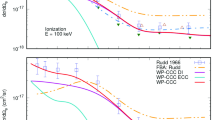Abstract
A time-dependent coupled-channel approach was used to calculate ionization, excitation, and energy-loss cross sections as well as energy spectra for antiproton and proton collisions with molecular hydrogen for impact energies 8 < E < 4000 keV.
Similar content being viewed by others
References
Knudsen, H., et al.: Ionization of helium and argon by very slow antiproton impact. Phys. Rev. Lett. 101, 043201 (2008)
Andersen, L.H., et al.: Non-dissociative and dissociative ionisation of H2 by 50–2000 keV antiprotons. J. Phys. B 23, L395 (1990)
Hvelplund, P., et al.: Ionization of helium and molecular hydrogen by slow antiprotons. J. Phys. B 27, 925 (1994)
Ermolaev, A.M.: The ratio R i for nondissociative ionization of molecular hydrogen by antiproton/proton impact. Hyperfine Interact. 76, 335 (1993)
Lühr, A., Saenz, A.: Antiproton collisions with molecular hydrogen. Phys. Rev., A 78, 032708 (2008)
Lühr, A., Saenz, A.: Antiproton and proton collisions with the alkali-metal atoms Li, Na, and K. Phys. Rev., A 77, 052713 (2008)
Lühr, A., et al.: Parameter-free one-center model potential for an effective one-electron description of molecular hydrogen. Phys. Rev., A 78, 042510 (2008)
Lühr, A., et al.: Interaction of antiprotons with Rb atoms and a comparison of antiproton stopping powers of the atoms H, Li, Na, K, and Rb. Hyperfine Interact. (2009)
Vanne, Y.V., Saenz, A.: Ionization of H2 in intense ultrashort laser pulses: parallel versus perpendicular orientation. J. Mod. Opt. 55, 2665 (2008)
Rudd, M.E., et al.: Cross sections for ionization of gases by 5–4000-keV protons and for electron capture by 5–150-keV protons. Phys. Rev., A 28, 3244 (1983)
Rudd, M.E., et al.: Electron production in proton collisions: total cross sections. Rev. Mod. Phys. 57, 965 (1985)
Liu, X., et al.: Electron-impact excitation and emission cross sections of the H2 Lyman and Werner systems. J. Geophys. Res. 103, 26739 (1998)
Shah, M.B., et al.: Ionisation of H2 by fast protons and multiply charged ions of He, Li, C, N and O. J. Phys. B 15, 3441 (1982)
Shah, M.B., et al.: Electron capture and ionisation in collisions of slow H + and He2 + ions with helium. J. Phys. B 22, 3037 (1989)
Gealy, M.W., et al.: Energy and angular distributions of electrons from ion impact on atomic and molecular hydrogen. I. 20–114-keV H + +H2. Phys. Rev., A 51, 2247 (1995)
Lodi Rizzini, E., et al.: Barkas effect for antiproton stopping in H2. Phys. Rev. Lett. 89, 183201 (2002)
Hauser, P., et al.: Slowing down of negative muons in gaseous H2 and determination of the stopping power. In: Schaller, L.A. (ed.) Muonic Atoms and Molecules, p. 235 (1993)
Author information
Authors and Affiliations
Corresponding author
Rights and permissions
About this article
Cite this article
Lühr, A., Saenz, A. Collisions of low-energy antiprotons with molecular hydrogen: ionization, excitation and stopping power. Hyperfine Interact 194, 59–64 (2009). https://doi.org/10.1007/s10751-009-0030-9
Published:
Issue Date:
DOI: https://doi.org/10.1007/s10751-009-0030-9




